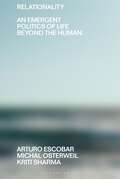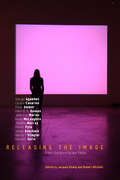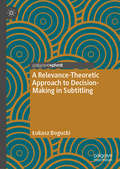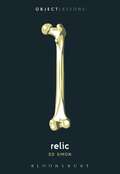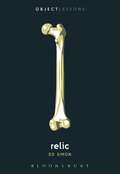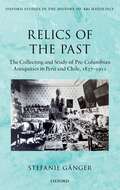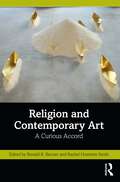- Table View
- List View
Relational Architectural Ecologies: Architecture, Nature and Subjectivity
by Peg RawesExamining the complex social and material relationships between architecture and ecology which constitute modern cultures, this collection responds to the need to extend architectural thinking about ecology beyond current design literatures. This book shows how the ‘habitats’, ‘natural milieus’, ‘places’ or ‘shelters’ that construct architectural ecologies are composed of complex and dynamic material, spatial, social, political, economic and ecological concerns. With contributions from a range of leading international experts and academics in architecture, art, anthropology, philosophy, feminist theory, law, medicine and political science, this volume offers professionals and researchers engaged in the social and cultural biodiversity of built environments, new interdisciplinary perspectives on the relational and architectural ecologies which are required for dealing with the complex issues of sustainable human habitation and environmental action. The book provides: 16 essays, including two visual essays, by leading international experts and academics from the UK, US, Australia, New Zealand and Europe; including Rosi Braidotti, Lorraine Code, Verena Andermatt Conley and Elizabeth Grosz A clear structure: divided into 5 parts addressing bio-political ecologies and architectures; uncertain, anxious and damaged ecologies; economics, land and consumption; biological and medical architectural ecologies; relational ecological practices and architectures An exploration of the relations between human and political life An examination of issues such as climate change, social and environmental well-being, land and consumption, economically damaging global approaches to design, community ecologies and future architectural practice.
Relational Architectural Ecologies: Architecture, Nature and Subjectivity
by Peg RawesExamining the complex social and material relationships between architecture and ecology which constitute modern cultures, this collection responds to the need to extend architectural thinking about ecology beyond current design literatures. This book shows how the ‘habitats’, ‘natural milieus’, ‘places’ or ‘shelters’ that construct architectural ecologies are composed of complex and dynamic material, spatial, social, political, economic and ecological concerns. With contributions from a range of leading international experts and academics in architecture, art, anthropology, philosophy, feminist theory, law, medicine and political science, this volume offers professionals and researchers engaged in the social and cultural biodiversity of built environments, new interdisciplinary perspectives on the relational and architectural ecologies which are required for dealing with the complex issues of sustainable human habitation and environmental action. The book provides: 16 essays, including two visual essays, by leading international experts and academics from the UK, US, Australia, New Zealand and Europe; including Rosi Braidotti, Lorraine Code, Verena Andermatt Conley and Elizabeth Grosz A clear structure: divided into 5 parts addressing bio-political ecologies and architectures; uncertain, anxious and damaged ecologies; economics, land and consumption; biological and medical architectural ecologies; relational ecological practices and architectures An exploration of the relations between human and political life An examination of issues such as climate change, social and environmental well-being, land and consumption, economically damaging global approaches to design, community ecologies and future architectural practice.
Relational Improvisation: Music, Dance and Contemporary Art
by Simon RoseRelational Improvisation explores the creative exchanges that occur between artistic disciplines through the practice of improvisation in performance. Building upon the growing research into improvisation, the book explores contemporary transdisciplinary collaborations between improvised music and other fields including dance and visual arts, offering insights from a wide range of practitioners. Author Simon Rose takes a ground-up approach that places value on lived experience and reflects the value of collaboration. Mirroring improvisation’s relationality, chapters are co-authored by musicians, dancers and visual artists from diverse backgrounds who are engaged in active artistic collaborations with the author.The relational approach allows for the inclusion of improvisation’s scope and many levels. Showcasing a range of different voices, the chapters address topics in artistic improvisation including cybernetics, interspecies work, working with light, phenomenology, sympoiesis and identity, and utilise a range of approaches including autoethnography and philosophical analysis. Considering the relationships of improvisation to emotion, space, embodiment and philosophy, this book shows how improvisation, collaboration and transdisciplinary artistic practices combine to generate new creative possibilities. It provides vital insights for practicing artists, arts researchers, philosophy and pedagogy and all those studying improvisation and collaborative creativity in contemporary music, dance and visual arts.
Relational Improvisation: Music, Dance and Contemporary Art
by Simon RoseRelational Improvisation explores the creative exchanges that occur between artistic disciplines through the practice of improvisation in performance. Building upon the growing research into improvisation, the book explores contemporary transdisciplinary collaborations between improvised music and other fields including dance and visual arts, offering insights from a wide range of practitioners. Author Simon Rose takes a ground-up approach that places value on lived experience and reflects the value of collaboration. Mirroring improvisation’s relationality, chapters are co-authored by musicians, dancers and visual artists from diverse backgrounds who are engaged in active artistic collaborations with the author.The relational approach allows for the inclusion of improvisation’s scope and many levels. Showcasing a range of different voices, the chapters address topics in artistic improvisation including cybernetics, interspecies work, working with light, phenomenology, sympoiesis and identity, and utilise a range of approaches including autoethnography and philosophical analysis. Considering the relationships of improvisation to emotion, space, embodiment and philosophy, this book shows how improvisation, collaboration and transdisciplinary artistic practices combine to generate new creative possibilities. It provides vital insights for practicing artists, arts researchers, philosophy and pedagogy and all those studying improvisation and collaborative creativity in contemporary music, dance and visual arts.
Relational Planning: Tracing Artefacts, Agency and Practices
by Monika Kurath, Marko Marskamp, Julio Paulos and Jean RueggThis volume introduces the notion of ‘relational planning’ through a collection of theoretical and empirical contributions that explore the making of heterogeneous associations in the planning practice. The analytical concept builds on recent approaches to complexity and materiality in planning theory by drawing on Science and Technology Studies (STS) of urban issues. It frames planning as a socio-material practice taking place within the multifaceted relations between artefacts, agency and practices. By way of this triad, spatial planning is not studied as a given, linear or technical process but rather problematized as a hybrid, distributed and situational practice. The inquiries in this collection thus describe how planning practices are negotiated and enacted in and beyond formal arenas and procedures of planning, and so make visible the many sites, actors and means of spatial planning.Addressing planning topics such as ecology, preservation, participation, rebuilding and zoning, this volume takes into account the uncertain world planning is embedded in. The implications of such a perspective are considered in light of how planning is performed and how it contributes to the emergence of specific socio-material forms and interactions. This is an invaluable read for all scholars of STS, Ecology, Architecture and Urban Planning.
Relationality: An Emergent Politics of Life Beyond the Human (Beyond the Modern)
by Arturo Escobar Michal Osterweil Kriti SharmaThis important new book argues that at the root of the contemporary crisis of climate, energy, food, inequality, and meaning is a certain core presupposition that structures the ways in which we live, think, act and design: the assumption of dualism, or the fundamental separateness of things.The authors contend that the key to constructing livable worlds lies in the cultivation of ways of knowing and acting based on a profound awareness of the fundamental interdependence of everything that exists – what they refer to as relationality. This shift in paradigm is necessary for healing our bodies, ecosystems, cities, and the planet at large. The book follows two interwoven threads of argumentation: on the one hand, it explains and exemplifies the modes of operation and the dire consequences of non-relational living; on the other, it elucidates the nature of relationality and explores how it is embodied in transformative practices in multiple spheres of life.The authors provide an instructive account of the philosophical, scientific, social, and political sources of relational theory and action, with the aim of illuminating the transition from living within seemingly ineluctable 'toxic loops' of unrelational living (based on ontological dualism), to living within 'relational weaves' which we might co-create with multiple human and nonhuman others.
Relationality: An Emergent Politics of Life Beyond the Human (Beyond the Modern)
by Arturo Escobar Michal Osterweil Kriti SharmaThis important new book argues that at the root of the contemporary crisis of climate, energy, food, inequality, and meaning is a certain core presupposition that structures the ways in which we live, think, act and design: the assumption of dualism, or the fundamental separateness of things.The authors contend that the key to constructing livable worlds lies in the cultivation of ways of knowing and acting based on a profound awareness of the fundamental interdependence of everything that exists – what they refer to as relationality. This shift in paradigm is necessary for healing our bodies, ecosystems, cities, and the planet at large. The book follows two interwoven threads of argumentation: on the one hand, it explains and exemplifies the modes of operation and the dire consequences of non-relational living; on the other, it elucidates the nature of relationality and explores how it is embodied in transformative practices in multiple spheres of life.The authors provide an instructive account of the philosophical, scientific, social, and political sources of relational theory and action, with the aim of illuminating the transition from living within seemingly ineluctable 'toxic loops' of unrelational living (based on ontological dualism), to living within 'relational weaves' which we might co-create with multiple human and nonhuman others.
Relaunching Titanic: Memory and marketing in the New Belfast
by William J. V. Neill Michael Murray Berna GristRelaunching Titanic critically considers the invocation of Titanic heritage in Belfast in contributing to a new ‘post-conflict’ understanding of the city. The authors address how the memory of Titanic is being and should be represented in the place of its origin, from where it was launched into the collective consciousness and unconscious of western civilization. Relaunching Titanic examines the issues in the context of international debates on the tension between place marketing of cities and other alternative portrayals of memory and meaning in places. Key questions include the extent to which the goals of economic development are congruous with the ‘contemplative city’ and especially the need for mature and creative reflection in the ‘post-conflict’ city, whether development interests have taken precedence over the need for a deeper appreciation of a more nuanced Titanic legacy in the city of Belfast, and what Belfast shares with other places in considering the sacred and profane in memory construction. While Relaunching Titanic focuses on the conflicted history of Belfast and the Titanic, it will have lessons for planners and scholars of city branding, tourism, and urban re-imaging.
Relaunching Titanic: Memory and marketing in the New Belfast
by William J. V. Neill Michael Murray Berna GristRelaunching Titanic critically considers the invocation of Titanic heritage in Belfast in contributing to a new ‘post-conflict’ understanding of the city. The authors address how the memory of Titanic is being and should be represented in the place of its origin, from where it was launched into the collective consciousness and unconscious of western civilization. Relaunching Titanic examines the issues in the context of international debates on the tension between place marketing of cities and other alternative portrayals of memory and meaning in places. Key questions include the extent to which the goals of economic development are congruous with the ‘contemplative city’ and especially the need for mature and creative reflection in the ‘post-conflict’ city, whether development interests have taken precedence over the need for a deeper appreciation of a more nuanced Titanic legacy in the city of Belfast, and what Belfast shares with other places in considering the sacred and profane in memory construction. While Relaunching Titanic focuses on the conflicted history of Belfast and the Titanic, it will have lessons for planners and scholars of city branding, tourism, and urban re-imaging.
Releasing the Image: From Literature to New Media
by Giorgio Agamben Mark Hansen Robert Mitchell Jacques Khalip Peter Geimer Cesare CasarinoIt has become a commonplace that "images" were central to the twentieth century and that their role will be even more powerful in the twenty-first. But what is an image and what can an image be? Releasing the Image understands images as something beyond mere representations of things. Releasing images from that function, it shows them to be self-referential and self-generative, and in this way capable of producing forms of engagement beyond spectatorship and subjectivity. This understanding of images owes much to phenomenology—the work of Husserl, Heidegger, and Merleau-Ponty—and to Gilles Deleuze's post-phenomenological work. The essays included here cover historical periods from the Romantic era to the present and address a range of topics, from Cézanne's painting, to images in poetry, to contemporary audiovisual art. They reveal the aesthetic, ethical, and political stakes of the project of releasing images and provoke new ways of engaging with embodiment, agency, history, and technology.
A Relevance-Theoretic Approach to Decision-Making in Subtitling
by Łukasz BoguckiThis book aims to investigate the process of decision-making in subtitling of feature films and entertainment series. The author uses Relevance Theory (Sperber and Wilson,1986) to argue that the technical, linguistic and translational constraints at work in subtitling result in a curtailed target text, and illustrates this argument by invoking examples drawn from the English-Polish subtitles of films and television series available through the subscription service Netflix. After introducing the current state of research on audiovisual translation within and outside the framework of translation studies, he presents the core concepts underpinning Relevance Theory and explains how it can be used to construct a model of the process of subtitling. This book will be of interest to students and scholars working in the fields of translation studies, audiovisual translation studies, and communication studies.
Reliable Face Recognition Methods: System Design, Implementation and Evaluation
by Harry WechslerThis book seeks to comprehensively address the face recognition problem while gaining new insights from complementary fields of endeavor. These include neurosciences, statistics, signal and image processing, computer vision, machine learning and data mining. The book examines the evolution of research surrounding the field to date, explores new directions, and offers specific guidance on the most promising venues for future research and development. The book’s focused approach and its clarity of presentation make this an excellent reference work.
Reliable Knowledge Discovery
by Honghua Dai James N. K. Liu Evgueni SmirnovReliable Knowledge Discovery focuses on theory, methods, and techniques for RKDD, a new sub-field of KDD. It studies the theory and methods to assure the reliability and trustworthiness of discovered knowledge and to maintain the stability and consistency of knowledge discovery processes. RKDD has a broad spectrum of applications, especially in critical domains like medicine, finance, and military. Reliable Knowledge Discovery also presents methods and techniques for designing robust knowledge-discovery processes. Approaches to assessing the reliability of the discovered knowledge are introduced. Particular attention is paid to methods for reliable feature selection, reliable graph discovery, reliable classification, and stream mining. Estimating the data trustworthiness is covered in this volume as well. Case studies are provided in many chapters. Reliable Knowledge Discovery is designed for researchers and advanced-level students focused on computer science and electrical engineering as a secondary text or reference. Professionals working in this related field and KDD application developers will also find this book useful.
Relic (Object Lessons)
by Dr. Ed SimonObject Lessons is a series of short, beautifully designed books about the hidden lives of ordinary things.Every culture, every religion, every era has enshrined otherwise regular objects with a significance which stretches beyond their literal importance. Whether the bone of a Catholic martyr, the tooth of a Buddhist lama, or the cloak of a Sufi saint, relics are material conduits to the immaterial world. Yet relics aren't just a feature of religion. The exact same sense of the transcendent animates objects of political, historical, and cultural significance.From Abraham Lincoln's death mask to Vladimir Lenin's embalmed corpse, Emily Dickinson's envelopes to Jimi Hendrix's guitar pick, relics are the objects which the faithful understand as being more than just objects. Material things of sacred importance, relics are indicative of a culture's deepest values. Object Lessons is published in partnership with an essay series in The Atlantic.
Relic (Object Lessons)
by Dr. Ed SimonObject Lessons is a series of short, beautifully designed books about the hidden lives of ordinary things.Every culture, every religion, every era has enshrined otherwise regular objects with a significance which stretches beyond their literal importance. Whether the bone of a Catholic martyr, the tooth of a Buddhist lama, or the cloak of a Sufi saint, relics are material conduits to the immaterial world. Yet relics aren't just a feature of religion. The exact same sense of the transcendent animates objects of political, historical, and cultural significance.From Abraham Lincoln's death mask to Vladimir Lenin's embalmed corpse, Emily Dickinson's envelopes to Jimi Hendrix's guitar pick, relics are the objects which the faithful understand as being more than just objects. Material things of sacred importance, relics are indicative of a culture's deepest values. Object Lessons is published in partnership with an essay series in The Atlantic.
Relics: Travels in Nature's Time Machine
by Piotr NaskreckiOn any night in early June, if you stand on the right beaches of America’s East Coast, you can travel back in time all the way to the Jurassic. For as you watch, thousands of horseshoe crabs will emerge from the foam and scuttle up the beach to their spawning grounds, as they’ve done, nearly unchanged, for more than 440 million years. Horseshoe crabs are far from the only contemporary manifestation of Earth’s distant past, and in Relics, world-renowned zoologist and photographer Piotr Naskrecki leads readers on an unbelievable journey through those lingering traces of a lost world. With camera in hand, he travels the globe to create a words-and-pictures portrait of our planet like no other, a time-lapse tour that renders Earth’s colossal age comprehensible, visible in creatures and habitats that have persisted, nearly untouched, for hundreds of millions of years. Naskrecki begins by defining the concept of a relic—a creature or habitat that, while acted upon by evolution, remains remarkably similar to its earliest manifestations in the fossil record. Then he pulls back the Cambrian curtain to reveal relic after eye-popping relic: katydids, ancient reptiles, horsetail ferns, majestic magnolias, and more, all depicted through stunning photographs and first-person accounts of Naskrecki’s time studying them and watching their interactions in their natural habitats. Then he turns to the habitats themselves, traveling to such remote locations as the Atewa Plateau of Africa, the highlands of Papua New Guinea, and the lush forests of the Guyana Shield of South America—a group of relatively untrammeled ecosystems that are the current end point of staggeringly long, uninterrupted histories that have made them our best entryway to understanding what the prehuman world looked, felt, sounded, and even smelled like. The stories and images of Earth’s past assembled in Relics are beautiful, breathtaking, and unmooring, plunging the reader into the hitherto incomprehensible reaches of deep time. We emerge changed, astonished by the unbroken skein of life on Earth and attentive to the hidden heritage of our planet’s past that surrounds us.
Relics: Travels in Nature's Time Machine
by Piotr NaskreckiOn any night in early June, if you stand on the right beaches of America’s East Coast, you can travel back in time all the way to the Jurassic. For as you watch, thousands of horseshoe crabs will emerge from the foam and scuttle up the beach to their spawning grounds, as they’ve done, nearly unchanged, for more than 440 million years. Horseshoe crabs are far from the only contemporary manifestation of Earth’s distant past, and in Relics, world-renowned zoologist and photographer Piotr Naskrecki leads readers on an unbelievable journey through those lingering traces of a lost world. With camera in hand, he travels the globe to create a words-and-pictures portrait of our planet like no other, a time-lapse tour that renders Earth’s colossal age comprehensible, visible in creatures and habitats that have persisted, nearly untouched, for hundreds of millions of years. Naskrecki begins by defining the concept of a relic—a creature or habitat that, while acted upon by evolution, remains remarkably similar to its earliest manifestations in the fossil record. Then he pulls back the Cambrian curtain to reveal relic after eye-popping relic: katydids, ancient reptiles, horsetail ferns, majestic magnolias, and more, all depicted through stunning photographs and first-person accounts of Naskrecki’s time studying them and watching their interactions in their natural habitats. Then he turns to the habitats themselves, traveling to such remote locations as the Atewa Plateau of Africa, the highlands of Papua New Guinea, and the lush forests of the Guyana Shield of South America—a group of relatively untrammeled ecosystems that are the current end point of staggeringly long, uninterrupted histories that have made them our best entryway to understanding what the prehuman world looked, felt, sounded, and even smelled like. The stories and images of Earth’s past assembled in Relics are beautiful, breathtaking, and unmooring, plunging the reader into the hitherto incomprehensible reaches of deep time. We emerge changed, astonished by the unbroken skein of life on Earth and attentive to the hidden heritage of our planet’s past that surrounds us.
Relics, dreams, voyages: World baroque
by Peter DavidsonRelics, dreams, voyages is a closely focused sequence of studies of worldwide connections in all the arts in the baroque period. Drawing on original research in libraries, collections, and archives in five countries, and in as many languages, this book draws many astonishing, unfamiliar and beautiful texts, things and events, into a cartography of the secret and strange patterns of baroque cultures worldwide. The visual arts are examined across a wide temporal and geographical span, and many subversive iconographies are decoded: at the French and English courts, in remote Scotland, in Nagasaki, in Valladolid. This books offers a new, extraordinary cultural geography of the baroque world, opening doors to many rich and strange cultural artefacts, from 'China to Peru.'
Relics, dreams, voyages: World baroque
by Peter DavidsonRelics, dreams, voyages is a closely focused sequence of studies of worldwide connections in all the arts in the baroque period. Drawing on original research in libraries, collections, and archives in five countries, and in as many languages, this book draws many astonishing, unfamiliar and beautiful texts, things and events, into a cartography of the secret and strange patterns of baroque cultures worldwide. The visual arts are examined across a wide temporal and geographical span, and many subversive iconographies are decoded: at the French and English courts, in remote Scotland, in Nagasaki, in Valladolid. This books offers a new, extraordinary cultural geography of the baroque world, opening doors to many rich and strange cultural artefacts, from 'China to Peru.'
Relics Of The Past: The Collecting And Study Of Pre-columbian Antiquities In Peru And Chile, 1837-1911 (Oxford Studies in the History of Archaeology)
by Stefanie GängerRelics of the Past tells the story of antiquities collecting, antiquarianism, and archaeology in Peru and Chile in the second half of the nineteenth and the early twentieth century. While the role of foreign travellers and scholars dedicated to the study of South America's pre-Columbian past is well documented, historians have largely overlooked the knowledge gathered and the collections formed among collectors of antiquities, antiquaries, and archaeologists born or living in South America during this period. The landed gentry, the clergy, and an urban bourgeoisie of doctors, engineers, and military officials put antiquities on display in their private mansions or bestowed them upon the public museums that were being formed by municipalities and governments in Santiago de Chile, Cuzco, or Lima. Men, and some few women, gathered antiquities on their journeys 'inland' and during sociable weekend excursions, but also on quotidian commercial voyages or in military campaigns. They bartered antiquities with their fellow collectors or haggled about their price on the antiquities market. In their hours of leisure, they marvelled at them, wrote about them, and disputed over their meaning, age, and interest in learned societies, informal gatherings, and at meetings in universities and public museums. This volume unveils a hitherto largely unknown world of antiquarian and archaeological collecting and learning in Peru and Chile.
Relics of War: The History of a Photograph
by Jennifer RaabHow a single haunting image tells a story about violence, mourning, and memoryIn 1865, Clara Barton traveled to the site of the notorious Confederate prison camp in Andersonville, Georgia, where she endeavored to name the missing and the dead. The future founder of the American Red Cross also collected their relics—whittled spoons, woven reed plates, a piece from the prison&’s &“dead line,&” a tattered Bible—and brought them back to her Missing Soldiers Office in Washington, DC, presenting them to politicians, journalists, and veterans&’ families before having them photographed together in an altar-like arrangement. Relics of War reveals how this powerful image, produced by Mathew Brady, opens a window into the volatile relationship between suffering, martyrdom, and justice in the wake of the Civil War.Jennifer Raab shows how this photograph was a crucial part of Barton&’s efforts to address the staggering losses of a war in which nearly half of the dead were unnamed and from which bodies were rarely returned home for burial. The Andersonville relics gave form to these absent bodies, offered a sacred site for grief and devotion, mounted an appeal on behalf of the women and children left behind, and testified to the crimes of war. The story of the photograph illuminates how military sacrifice was racialized as political reconciliation began, and how the stories of Black soldiers and communities were silenced.Richly illustrated, Relics of War vividly demonstrates how one photograph can capture a precarious moment in history, serving as witness, advocate, evidence, and memory.
Relics of War: The History of a Photograph
by Jennifer RaabHow a single haunting image tells a story about violence, mourning, and memoryIn 1865, Clara Barton traveled to the site of the notorious Confederate prison camp in Andersonville, Georgia, where she endeavored to name the missing and the dead. The future founder of the American Red Cross also collected their relics—whittled spoons, woven reed plates, a piece from the prison&’s &“dead line,&” a tattered Bible—and brought them back to her Missing Soldiers Office in Washington, DC, presenting them to politicians, journalists, and veterans&’ families before having them photographed together in an altar-like arrangement. Relics of War reveals how this powerful image, produced by Mathew Brady, opens a window into the volatile relationship between suffering, martyrdom, and justice in the wake of the Civil War.Jennifer Raab shows how this photograph was a crucial part of Barton&’s efforts to address the staggering losses of a war in which nearly half of the dead were unnamed and from which bodies were rarely returned home for burial. The Andersonville relics gave form to these absent bodies, offered a sacred site for grief and devotion, mounted an appeal on behalf of the women and children left behind, and testified to the crimes of war. The story of the photograph illuminates how military sacrifice was racialized as political reconciliation began, and how the stories of Black soldiers and communities were silenced.Richly illustrated, Relics of War vividly demonstrates how one photograph can capture a precarious moment in history, serving as witness, advocate, evidence, and memory.
Relief Marble Bust of Cinzio Benincasa (SEB)
by RnibThis is a marble relief from the 15 century. The relief is recessed within a moulded frame and has an inscription in carved capital letters in a strip across the base. The outer edge of the frame has large chips in it making the edge uneven. The sitter, a young man in his mid to late twenties, is shown in profile to the right, wearing a high cap encircled with a laurel wreath tied at the back with a ribbon. The tactile image shows the detail of the relief and moulded frame and has a key, in two columns, at the top of the page. The main part of the moulded frame is shown with a solid texture with a line for the inner most part of the frame. The large chips can be felt on the outer edge. The high cap and ribbon is shown with a rough texture which is also used to show the tunic. Solid shapes show the laurel wreath, chain and buttons on the front of the tunic. The facial features have been shown with lines.
Religion and Contemporary Art: A Curious Accord
by Ronald R. BernierReligion and Contemporary Art sets the theoretical frameworks and interpretive strategies for exploring the re-emergence of religion in the making, exhibiting, and discussion of contemporary art. Featuring essays from both established and emerging scholars, critics, and artists, the book reflects on what might be termed an "accord" between contemporary art and religion. It explores the common strategies contemporary artists employ in the interface between religion and contemporary art practice. It also includes case studies to provide more in-depth treatments of specific artists grappling with themes such as ritual, abstraction, mythology, the body, popular culture, science, liturgy, and social justice, among other themes. It is a must-read resource for working artists, critics, and scholars in this field, and an invitation to new voices "curious" about its promises and possibilities.
Religion and Contemporary Art: A Curious Accord
Religion and Contemporary Art sets the theoretical frameworks and interpretive strategies for exploring the re-emergence of religion in the making, exhibiting, and discussion of contemporary art. Featuring essays from both established and emerging scholars, critics, and artists, the book reflects on what might be termed an "accord" between contemporary art and religion. It explores the common strategies contemporary artists employ in the interface between religion and contemporary art practice. It also includes case studies to provide more in-depth treatments of specific artists grappling with themes such as ritual, abstraction, mythology, the body, popular culture, science, liturgy, and social justice, among other themes. It is a must-read resource for working artists, critics, and scholars in this field, and an invitation to new voices "curious" about its promises and possibilities.



